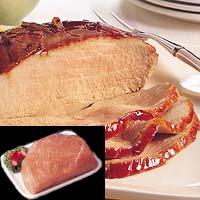Pork Roast

Varieties
The tender centre loin roast (also called centre rib roast) contains bones, which give it a flavourful flavour but make it harder to slice. Your butcher can remove the backbone and transform this roast into rack of pork or crown roast of pork.
Pork Tenderloin Roast
The pork tenderloin is a completely boneless strip of muscle and is considered the leanest and most tender pork roast; it is also the most expensive.
Pork Blade Roast
The blade roast, an economical cut, is available either bone-in or boneless, and is lightly marbled with fat. Pork blade roast is also known as pork loin rib end.
Boston Butt
Sometimes called pork shoulder roast, Boston butt is available either boneless or bone-in. It makes a somewhat fatty but economical roast.
Pork Picnic Arm
Pork picnic arm is a fatty, bony cut, and is often barbecued.
Copyright © 2024 TraceGains, Inc. All rights reserved.
Learn more about TraceGains, the company.
The information presented in the Food Guide is for informational purposes only and was created by a team of US–registered dietitians and food experts. Consult your doctor, practitioner, and/or pharmacist for any health problem and before using any supplements, making dietary changes, or before making any changes in prescribed medications. Information expires December 2024.



 We are proud to announce that
We are proud to announce that  As the market evolves, customers increasingly request a wider variety of omega-3 options for their lipid...
As the market evolves, customers increasingly request a wider variety of omega-3 options for their lipid...  Maintaining healthy glucose levels is crucial for preventing metabolic conditions like diabetes,...
Maintaining healthy glucose levels is crucial for preventing metabolic conditions like diabetes,...  Looking at formulating a new vitamin blend? Discover
Looking at formulating a new vitamin blend? Discover 







































